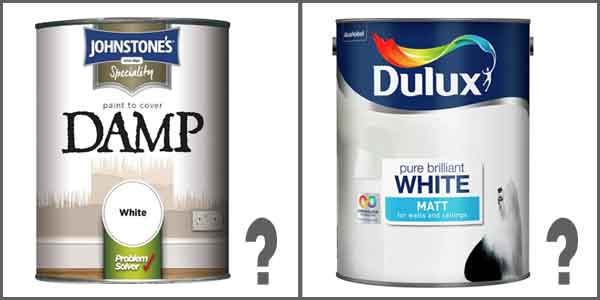The DIY Fix is reader supported. When you buy after clicking a link on our site, we may earn an affiliate commission.
When dealing with damp in a property, there is a three-step process that you must follow to completely remove the problem.
- You need to identify the exact cause of the problem.
- Once you have located the problem, it must be fixed correctly.
- Finally, you can deal with internal issues, such as new plaster work, woodwork, and decorations.
It is extremely important that you don’t skip the first two steps. If you don’t rectify the underlying issue, then even the best damp-proof paint won’t stop the problem from returning.
Only once you have stopped damp entering your property, should you start to decorate.

Once you stopped the damp, you should also allow the area to completely dry out. This can be sped up with heat, good ventilation, and the use of a dehumidifier.
So, once everything is dry, what paint should you use after damp proofing? Can you use a normal emulsion, or should you use specialist damp paint?
In many cases you will be able to use a standard emulsion. This should be fine, providing the damp problem has been completely fixed and no moisture remains.
For an extra layer of safety, you could also add a protective undercoat, using a damp-proof paint. This would give an extra layer of protection, to stop future damp. It can also be painted over, so shouldn’t have any effect on the finish.
When is damp proof paint a good idea?
There are many possible ways that damp can enter a home.
- It can rise from the ground below.
- Penetrate through the walls.
- Roof problems can allow water to leak in.
There are also internal issues, such as burst pipes and condensation.
However, not all of these will require damp proof paints once the problem is fixed.
The main time a damp-proof paint will be useful, is after cases of penetrating or rising damp.
When dealing with these types of damp, you may be applying fresh plaster directly to the affected surface. Alternatively, you may not need to remove plaster at all.
In either scenario, the plaster is still in contact with the previously affected surface. A damp-proof paint could help here, due to several reasons.
- There could still be small amounts of moisture trapped in the wall or old plaster.
- Hygroscopic salts
- Help to protect if the problem returns
If you do a good job of drying the surface, then trapped moisture should be less of a problem. Also, if damp proofing work has been carried out correctly, the main issue should really not return.
However, hygroscopic salts are a real potential problem. These are salts that collect in the brickwork and mortar of your home, they are carried there by the damp, as it moves through the building materials. This can come from the ground below, and outside your home.
The main problem this causes, is that these salts are highly absorbent. They will draw moisture from within the masonry, as well as from condensation inside your home. This can lead people to believe the original problem has not been resolved. When in fact, it is a new problem.
The good thing about a damp-proof paint, is it will stop moisture penetrating the surface. Plus, it will stop condensation being drawn to these salts.
When you can use normal paints after damp proofing
There are many instances, when you will not need to use a damp proof paint after damp proofing.
A good example here, would be when you are applying fresh plasterboard’s internally. These new boards are not usually in direct contact with the previously affected surface.
A few examples of this include things like:
- Attaching boards with a dry wall adhesive (also known as dot and dab). When you dot dab boards onto the wall, the only thing in contact with the original surface, is the adhesive.
Providing the original damp proofing was done correctly, it is unlikely that enough moisture could pass through the adhesive, through the board and then through the skimmed plaster. - Plaster boards could be on an internal stud wall or battens further separating them from affected surfaces.
- Perhaps you have replaced a ceiling after a roof leak. Again, this would not be in direct contact with the surface that had the damp problem
In any of these cases, a normal emulsion will be just fine, and a damp proof paint would be completely unnecessary.
Conclusion – The most important thing!
In most instances, the paint you use after damp proofing isn’t that important. Sure, you can get some extra protection by applying a damp proof paint, but this should be a secondary consideration.
By far the most important thing, is to fix the underlying damp problem. If you don’t get rid of the original cause, the problem will persist, no matter what paint you use.
Therefore, it is so important to make sure you fix the issue properly. If you are in any doubt of how to do this, just call in an expert.
Most local damp proofing companies will come out and diagnose the problem for free. Then it is up to you if you hire them or opt to do the work yourself.
Also, if you use damp proofing comparison sites, you can usually get massive reductions on prices. It is not uncommon to see savings as high as 50% off.
To see our favourite damp proof comparison site and get several local quotes, Click Here

